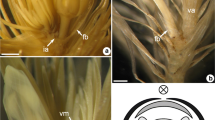Abstract
Observations on the vascular floral anatomy, carpel morphology and floral biology ofHeloniopsis orientalis are presented. The lower flowering pedicel has six large bundles which lack an enclosing sclerenchymatous sheath. At mid-pedicel, branch bundles originate via radial divisions from each of these bundles. Subsequently, there is a vascular ring of 12 bundles below the receptacle. The six smaller bundles which are derived from alternate pedicel bundles eventually establish all of the ventral gynoecium supply. The six larger bundles supply the tepals, stamens and dorsal gynoecial vasculature. The simple dorsals do not branch or fuse in their vertical ascent.
The ventral and placental supplies are far more complex. Fusion occurs between paired sets of the six smaller pedicel bundles along the septal radii and results in a submarginal laminal ventral network. An independent ventral plexus is formed in each septum and from each plexus two septal axials, of which the innermost has a reversed xylem-phloem disposition, and four placental bundles are derived. Two placental bundles are associated with each septal axial. Basally the septa are fused centrally, but are freed at mid-gymoecial height.
The broadly tri-lobed, tri-carpellate gynoecium is depressed terminally where the erect, hollow style with its capitate stigma is attached. Dorsal grooves are present: the fruit is loculicidally dehiscent. There are no septal glands due to complete lateral fusion of the septal wings. Basally each of the six equal tepals has a saccate nectary. The similarity in vascular anatomy and carpel morphology of the AsianHeloniopsis and eastern North American endemic,Helonias bullata, justifies their position in the same tribe.
Similar content being viewed by others
References
Anderson, C.E. 1940. Some studies on the floral anatomy of the Liliales. Ph. D. Diss., Cornell Univ., Ithaca p. 62–65.
Chuang, T., C.Y. Chao, W.W.L. Hu andS.C. Kwan. 1962. Chromosome numbers of the vascular plants of Taiwan I. Taiwania8: 51–66.
Darlington, C.D. andA.P. Wylie. 1955. Chromosome Atlas of Flowering Plants p. 519. Allen and Unwin, London.
Engler, A. 1888. Liliaceae.In: A. Engler and E. Prantl, ed., Die natürlichen Pflanzenfamilien, II5: 21–22. Engelmann Verlag, Leipzig.
Fedorov, A.A. 1969. Chromosome Numbers of Flowering Plants p. 395. (in Russian). Nauk, Leningrad.
Fernald, M.L. 1950. Gray's Manual of Botany 8 ed. p. 424. American Book Co., New York.
Fuchs, C. 1963. Fuchsin staining with NaOH clearing for lignified elements of whole plants or plants organs. Stain Tech.38: 141–144.
Gray, A. 1859. Botany of Japan. Memoire Amer. Acad. New Ser.6: 377–452.
Hsu, C.C. 1971. Preliminary chromosome studies on the vascular plants of Taiwan IV. Counts and some systematic notes on some Monocotyledons. Taiwania16: 123–136.
Hutchinson, G. 1959. The Families of Flowering Plants. Vol. II. Monocotyledons p. 591–596, Oxford Press, London.
Johnsen, D.A. 1940. Plant Microtechnique. McGraw-Hill, New York.
Johnson, R.G. 1969. A taxonomic and floristic study of the Liliaceae and allied families in the southeastern United States. Ph. D. Diss., West virginia Univ., Morgantown p. 26–27.
Kawano, S. andJ. Masuda. 1980. The productive and reproductive biology of flowering plants VII. Resource allocation and reproductive capacity in wild populations ofHeloniopsis orientalis (Thunb.) C. Tanaka (Liliaceae). Oecologia45: 307–317.
Kitamura, S., G. Murata andT. Koyama. 1975. Coloured Illustrations of Herbaceous Plants of Japan Vol. III. (Monocotyledoneae) Revised ed. p. 151 (in Japanese). Hoikusha Publishing Co., Osaka.
Krause, K. 1930. Liliaceae.In: A. Engler and E. Prantl, ed., Die natürlichen Pflanzenfamilien. Aufl. 2,15a: 257–260. Engelmann Verlag, Berlin.
Miller, E.W. 1930. A preliminary note on the cytology of the Melanthioideae section of the Liliaceae. Proc. Univ. Durham Phil. Soc.8: 267–271.
Nakamura, T. 1967. Cytological studies in family Liliaceae of Japan II. The karyotype analysis in genusHeloniopsis. La Kromosomo71: 2316–2321.
Nakajima, G. 1933. Chromosome number in some Angiosperms. Jap. J. Genetics9: 1–5.
Ohwi, J. 1965. Flora of Japan p. 284. Shibundo, Tokyo.
Ono, T. 1926. Embryologische Studien anHeloniopsis breviscapa. Sci. Rep. Tohoku Imp. Univ., Ser. 4, Biol.2: 93.
Sakai, K. 1934. Studies on the chromosome number in alpine plants. I. Jap. J. Genet.9: 226–230.
Sass, J.E. 1958. Botanical Microtechnique. Iowa State Univ. Press, Ames.
Sato, D. 1942. Karyotype alternation and phylogeny in Liliaceae and allied families. Jap. J. Bot.12: 57–161.
Utech, F.H. 1978a. Floral vascular anatomy ofMedeola virginiana L. (Liliaceae-Parideae=Trilliaceae) and tribal note. Ann. Carnegie Mus.47: 13–28.
— 1978b. Comparison of the vascular floral anatomy ofXerophyllum asphodeloides (L.) Nutt. andX. tenax (Pursh) Nutt. (Liliaceae-Melanthiodideae). Ann. Carnegie Mus.47: 147–167.
— 1978c. Vascular floral anatomy ofHelonias bullata L. (Liliaceae-Helonieae), with a comparison to the AsianHeloniopsis orientalis. Ann. Carnegie Mus.47: 169–191.
— 1978d. Floral vascular anatomy ofPleea tenuifolia Michx. (Liliaceae-Tofieldieae) and its ressignment toTofieldia. Ann. Carneige Mus.47: 423–454.
— 1978e. Floral vascular anatomy of the monotypic JapaneseMetanarthecium luteoviride Maxim. (Liliaceae-Melanthioideae) Ann. Carnegie Mus.47: 455–477.
— 1979a. Floral vascular anatomy of the HimalayanTheropopon pallidus Maxim. (Liliaceae-Convallarieae). Ann. Carnegie Mus.48: 25–41.
— 1979b. Floral vascular anatomy ofScoliopus bigelovii Torrey (Liliaceae-Parideae=Trilliaceae) and tribal note. Ann. Carnegie Mus.48: 43–71.
and. 1975. Biosystematic studies inErythronium (Liliaceae-Tulipeae) II. Floral anatomy ofE. japonicum Decne. Bot. Mag. Tokyo88: 177–185.
— and — 1976. Biosystematic studies onMaianthemum (Liliaceae-Polygonatae) VIII. Vascular floral anatomy ofM. dilatatum, M. bifolium andM. canadense. Bot. Mag. Tokyo89: 145–157.
Author information
Authors and Affiliations
Additional information
Research and publication supported in part by the M. Graham Netting Research Fund through a grant from the Cordelia Scaife May Charitable Trust, the U. S.—Japan Cooperative Science Program Grant GF-41367, the Japan Society for the Promotion of Science, and Grant-in-Aid No. 934053 from the Ministry of Education, Japan.
Rights and permissions
About this article
Cite this article
Utech, F.H., Kawano, S. Vascular floral anatomy of the east asianHeloniopsis orientalis (Thunb.) C. Tanaka (Liliaceae-Helonieae). Bot Mag Tokyo 94, 295–311 (1981). https://doi.org/10.1007/BF02493391
Received:
Issue Date:
DOI: https://doi.org/10.1007/BF02493391




